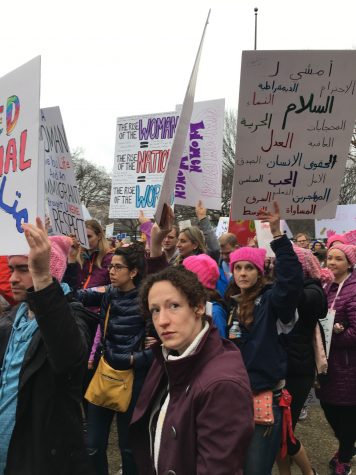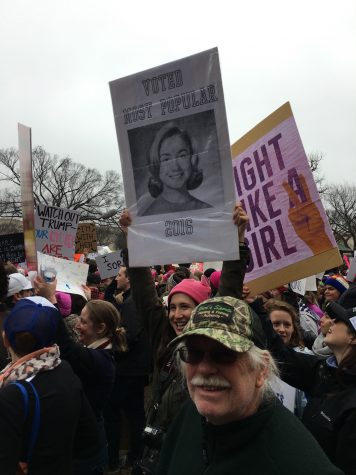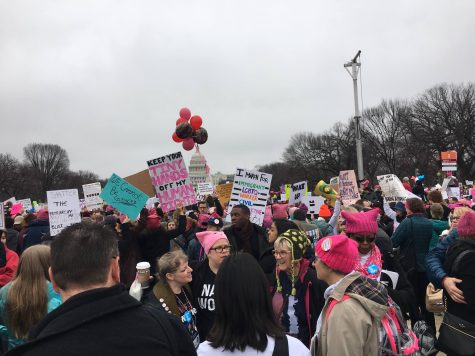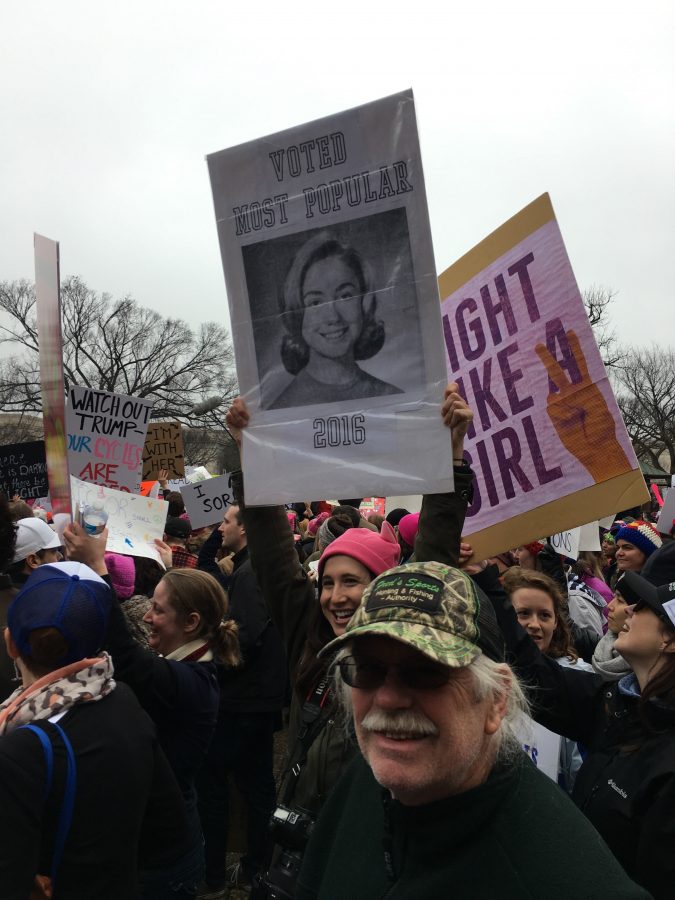Dispatch from DC: The Wire at the Women’s March
January 24, 2017
At 8:00 am on Saturday, Jan. 21, the Dunn-Loring metro station in Northern Virginia just outside Washington, DC, reverberated with the energy of hundreds of people carrying home-made posters and wearing knitted pink hats with pussy-cat ears. Crowds on the platform cheered for passing trains too full to stop. Everyone was going to the Women’s March on Washington. As I waited for a train, I asked a group of women in pussy hats why they had come.
“We’re here to show the new administration that we are watching,” said one woman, “and we are more vigilant than we’ve ever been.” She and a group of six friends drove together from Boston the day before to attend the day’s events.
“You look at this, and all you think is ‘don’t piss off women,’” another said. “I think this sends a message: black, white, gay, straight, Muslim, Jewish, Christian, old, young. Politics is not a spectator sport.”

On most days, your average DC metro train more closely resembles a library than a discotheque. But on Saturday morning, our train thumped with upbeat lady-power anthems like Fifth Harmony’s “BO$$” (“Boss, Michelle Obama!”), and Beyoncé’s “Run the World (Girls).”
Called the “Million Woman March” when first conceived after the election in November, the event was originally criticized as yet another example of white women ignoring and excluding activists of color. Black feminists who recalled the “Million Woman March” of 1997, when 750,000 black women marched for equality in Philadelphia, charged that their name had been usurped.
Organizers of this event quickly changed the name to simply “The Women’s March.” The new name was intended to express a commitment to intersectional feminism, a wave of feminism that embraces women with intersecting identities across race, gender, sexuality, ability, ethnicity and age. Intersectional activists representing a variety of groups united under the banner “Women’s Rights Are Human Rights and Human Rights Are Women’s Rights.”
By the time I made my way through crowded streets to the rally point around 9:30 am, there were already too many people in attendance to hear the speakers–let alone to see the main stage tucked in the crook of a narrow street near the Capitol. Navigating the current of people flowing across Washington’s National Mall, I ran into a group of volunteers for the Human Rights Campaign (HRC). The HRC is a national organization that advocates for LGBTQ rights whose logo has become an international symbol for LGBTQ equality. In his Planned Parenthood t-shirt, volunteer Tad Green said he hopes the Women’s March encourages people to pay attention to issues that may not affect them directly.
“We can’t become complacent when it comes to LGBTQ rights, women’s rights, minority rights, and [rights for] those that are oppressed. We are seeing a group of people who are energized in a way we haven’t seen in a long time,” he said.
Green’s colleague, Brian Callahan, shared similar thoughts. “On some level I think it’s good [Trump was elected],” Callahan said. “I feel more motivated to get involved and speak up.” When I asked him what advice he had for young people, he smiled and said, “Take time to find the truth.”
Around us, women of all ages—some with their families—chanted. “My body, my choice,” one group of women called. “Her body, her choice!” responded a group of enthusiastic men. Other marchers followed the chants of anti-Trump activist groups like J20, shouting, “This is what democracy looks like,” “We need a leader, not a creepy tweeter,” and “Say it loud, say it clear, immigrants are welcome here.”

The crowd continued to grow throughout the morning. Long, polite lines formed in front of the occasional unlocked port-a-potty. Portable toilets installed for the inauguration still lined the streets, but the vast majority had been cable-locked on Saturday and were conspicuously inaccessible to marchers.
Though the Women’s March began less than 24 hours after the inauguration, I spoke with only a couple of marchers who attended both events. High school students Anthony Guzman and Rodney Smith had ridden 13 hours on a bus from Chicago with their media class. While both were too young to vote in the election, they were worried when they learned Trump would be the next president. But the crowd at the inauguration surprised them.
“At first I just wanted to come for the experience,” Guzman said, “but yesterday was eye opening because not everyone was racist. [Trump supporters] had a good reason why they voted for him.”
Smith added that while he does not necessarily support Trump, he is optimistic. “We don’t know what he’s really going to do, but I’m willing to give him a chance,” he said.
Others were more skeptical. Tanisha Pierre, a second-year student at Moravian College in Bethlehem, Pennsylvania, proudly proclaimed, “This is our inauguration day.”
As a black woman, Pierre told me, she doesn’t want the new president to take the country back to a time that “wasn’t very great.” Holding a poster emblazoned with the profiles of five women and the words “Women Unite,” Pierre added that as an intersectional feminist, she hopes the Women’s March movement will become more inclusive.
“I don’t agree with the poster completely because it doesn’t show everybody,” she said. “It doesn’t show every color of the spectrum; it’s missing a disability … but it’s a start.”

By 1:30 pm, when the march was scheduled to start, over 500,000 people had showed up to the event in DC. The crowd spanned the entire two-mile parade route, rendering the actual march impossible. I stood on the steps of the Smithsonian’s National Air and Space Museum watching rivers of foot-traffic ebb and flow.
A man wearing a camouflage “Make America Great Again” hat walked past me and smiled. “I’m just going up to the museum,” he said. “Have a good march.”
I expected the marchers to say something rude to him about his hat, but nobody did.
At about 3:30 pm, the crowd began to disperse as some of us headed home the way we came—a little cold, a little hungry, but also energized. All of my worst expectations about people had proven unwarranted. So many people showed up, with different signs proclaiming different causes. But we all came. Not all of us agreed with one another, but we were all out there. And that’s what matters.






Ellen • Jan 24, 2017 at 12:04 pm
Thanks for a great report.